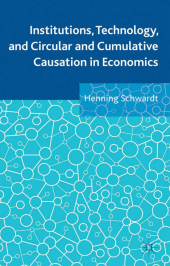 Neuerscheinungen 2013Stand: 2020-01-07 |
Schnellsuche
ISBN/Stichwort/Autor
|
Herderstraße 10
10625 Berlin
Tel.: 030 315 714 16
Fax 030 315 714 14
info@buchspektrum.de |

Henning Schwardt
Institutions, Technology, and Circular and Cumulative Causation in Economics
1st ed. 2013. 2013. viii, 247 S. 216 mm
Verlag/Jahr: SPRINGER PALGRAVE MACMILLAN; PALGRAVE MACMILLAN UK 2013
ISBN: 1-349-46243-8 (1349462438)
Neue ISBN: 978-1-349-46243-8 (9781349462438)
Preis und Lieferzeit: Bitte klicken
The book investigates the relation between technology and institutions and their mutual influence during processes of development and change and illustrates this on the development process in Argentina after 1946. General and case-study specific policy recommendations are offered.
1. Introduction PART I: CONCEPTS OF AND MODELS FOR GROWTH AND DEVELOPMENT DYNAMICS 2. Neoclassical Growth Models and Economic Development 3. Exogenous Growth Models 4. Endogenous Growth Models 5. Discussion 6. The ´High Theory of Development´ 7. General Outline of Development Economics 8. Big Push, Balanced Growth, and Unbalanced Growth, and the Dual Economy 9. Discussion 10. New Institutional Economics 11. NIE - Collective Action Problems 12. NIE - Transaction Costs 13. Discussion 14. Original Institutional Economics 15. Veblen´s Foundations for an Institutional Economics 16. Developments in the OIE Body of Theory 17. Institutions 18. Technology 19. Circular and Cumulative Causations 20. Discussion 21. Summary PART II: THE ANALYTICAL FRAMEWORK: INSTITUTIONS, TECHNOLOGY, AND CIRCULAR AND CUMULATIVE CAUSATION 22. A Categorization of Growth and Development Effects 23. An Evolutionary-Institutional Model of Economic Development 24. Institutions and Economic Development 25. Technology - Skills 26. Technology - Equipment 27.Integrating the Principal Influence Factors in Processes of Development and Change 28. Case Studies based on an Evolutionary-Institutional Model of Economic Development PART III: ECONOMIC DEVELOPMENT IN ARGENTINA AFTER 1946 29. Macroeconomic and Sectoral Development after 1946 30. Macroeconomic Development: General Growth Performance 31. Macroeconomic Development: Investment 32. Macroeconomic Development: Fiscal Accounts and External Sector 33. Fiscal Accounts 34. External Sector 35. Macroeconomic Development: Inflation and Unemployment 36. Inflation 37. Unemployment 38. Sectoral Development: Changes in Sectoral Structure and Production 39. Sectoral Structure 40. Sectoral Production 41. Summary and Current Structures 42. Political Changes and Economic Policies - Juán D. Perón, 1946-1955 43. Background of the Policy Decisions Taken 44. Outline of Perón´s Economic Policies 45. Interest Groups and Political Objectives 46. Inflation as a Sign for Persistent Structural Problems 47. Summary - The Foundation for Subsequent Developments 48. Political Changes and Economic Policies - The Alternation of Military and Civilian Rule, 1955-1976 49. Overview over the Political Development of the Period 50. The ´Revolución Libertadora´ Dictatorship, 1955-1958 51. The Presidency of Arturo Frondizi, 1958-1962 52. The Presidency of José M. Guido, 1962-1963 53. The Presidency of Arturo U. Illia, 1963-1966 54. The ´Revolución Argentina´ Dictatorship, 1966-1973 55. The Second Peronist Government, 1973-1976 56. Political Changes and Economic Policies - ´El Proceso de Reorganización Nacional´, 1976-1983 57. Political Development 58. General Outline of Economic Policies 59. Consequences of the Policies Implemented 60. Political Changes and Economic Policies - The Transition to Democracy and its Consolidation 1983-1999 61. The Presidency of Raúl Alfonsín, 1983-1989 62. The Presidency of Carlos S. Menem, 1989-1999 63. Political Changes and Economic Policies - The Collapse and Recovery of the Economy after 2001-02 64. The General Institutional Framework 65. Main Tendencies Identified 66. Economic Development until 1975 67. Political and Social Developments until 1975 68. Economic Policies after 1975 and their Consequences for Development 69. Summary PART IV: CONSEQUENCES FOR DEVELOPMENT POLICIES 70. Recent Policy Focuses 71. General Outlines for Development Policy 72. Consequences for Development Policy in Argentina


